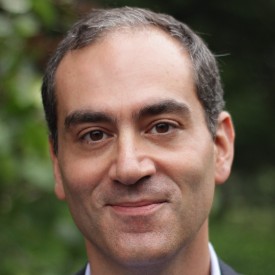Guy Leschziner is a clinical neurologist and a professor of neurology and sleep medicine based in London. He sees patients with a range of neurological and sleep disorders. He presented a series on sleep and neurology for BBC World Service and Radio 4.
What’s the big idea?
For millennia, actions of wrongdoing have been framed as sins, as exemplars of immorality. But modern science is discovering that the qualities which Christianity famously framed as the Seven Deadly Sins are often driven by alterations to brain structure and function that are largely beyond an individual’s control. How do we define the line between pathology and evil when there are countless biological reasons for why we behave in the ways that we do?
Below, Guy shares five key insights from his new book, Seven Deadly Sins: The Biology of Being Human. Listen to the audio version—read by Guy himself—in the Next Big Idea App.

1. Brain diseases and their treatments can all influence sin.
All pills have potential side effects. Sometimes, these side effects are physical, but occasionally, medicines can fundamentally change our actions. Drugs used to treat Parkinson’s disease can make us more impulsive, amplify sexual desires, possibly change our sexual preferences, or make us eat compulsively. These medications alter the chemistry that underlies those circuits of the brain that mediate pleasure and reward. Steroids, widely used to treat inflammation, can result in dramatic grandiosity, inflating our sense of self-importance. Certain anti-seizure medications can cause catastrophic elevations in wrath and resultant aggression, changing people’s lives for the worse.
Those drugs change the functions of the brain through their effects on the circuitry that mediates our emotions and actions. But changes to the structure of the brain, also affecting those regions that are responsible for driving or inhibiting behaviors, can also have similar results. Tumors, stroke, trauma, degeneration—all of these can cause hypersexuality, extreme overeating, pathological envy or pride, or an inability to control basic impulses. Studying individuals with changed brain structure or affected circuitry provides important insights into the brain regions responsible for our day-to-day behavior and how it can go awry.
2. Factors affecting our behavior can be present from the moment of conception.
The genes we inherit from the first spark of life can have profound effects on our future personality. One gene, known as the warrior gene, can affect levels of aggression—in fact, to such an extent that variants in that gene, called MAOA, have been used as mitigation for people convicted of violent offenses. Mutations of this gene can result in a syndrome causing males to be highly prone to violent outbursts, often resulting in criminality, including rape, arson, and murder.
Our genetic inheritance may also surprisingly impact how we interact with our environment. One gene variant associated with aggression has been associated with increased rates of gun-carrying pre-9/11 but did not seem to have an impact after 9/11 when threat levels were elevated.
“Mutations of this gene can result in a syndrome causing males to be highly prone to violent outbursts, often resulting in criminality, including rape, arson, and murder.”
Similarly, a variety of both common genes and rare mutations can transform our appetite and propensity to gain weight. One of the individuals in my book, Alex, is a young woman whose genes have changed how a small area of her brain called the hypothalamus functions. She is destined never to sate her hunger, always to feel ravenous, to eat without limits.
3. Environmental circumstances influence our sins.
The Jesuits knew well the effects of our upbringing on our future behaviors. Saint Ignatius Loyola, the founder of the Jesuit order, stated, “Give me a child until he is seven, and I will give you the man.” We now know that childhood can fundamentally shape our brains, and so define our character.
One of the most potent forces shaping our personalities is parental influence. Grow up in a stressful or traumatic environment, and this predisposes to increased aggression or anger. People with problematic aggression show structural differences in parts of the brain responsible for emotional regulation, as well as changes in brain biochemistry. Childhood adversity may directly affect brain development through its effects on hormones and how genes are regulated. Similarly, parenting style has major effects on other personality traits like narcissism. While we think we may be encouraging self-esteem in our children, over-praise or overevaluation of how special a child is results in narcissism rather than self-esteem.
Environmental factors have lifelong effects. In the winter of 1944, the Netherlands were gripped by famine. Initially, this was triggered by the Nazis. They banned food transport as punishment for a call to strike by the Dutch government, which was trying to support the Allies marching across Western Europe. A harsh winter followed, freezing the canals that usually permitted food transport from the country’s rural east to the urban west. The average food intake dropped from 1800 calories to 400-800 calories per day and affected everyone, children and pregnant women included.
“While we think we may be encouraging self-esteem in our children, over-praise or overevaluation of how special a child is results in narcissism rather than self-esteem.”
The aftermath of this period was surprising. Long-term follow-up of children born to mothers who had been pregnant during the famine showed startling results. Depending on when in the pregnancy the mothers starved, children showed different responses. Those who were in the latter stages of pregnancy produced underweight babies who remained small in adulthood. However, those starving in the first stages of pregnancy produced normal-weight babies who grew up to be more obese, with higher rates of cardiovascular disease. The conclusion was that starvation very early in our development causes changes in the vital organs that influence how we consume and process food.
4. Sins have biological advantages and evolutionary imperatives.
For all the personality traits that form the basis of the Seven Deadly Sins, there are people who sit at the extremes. Most of us have moderate levels of every single one of these traits. They are the basis of what it means to be human, and each of them serves biological imperatives.
Without lust, we are destined not to reproduce, to become extinct. Without gluttony, we will starve in times of famine. Without jealousy, we risk raising children that are not our own or losing the support of a partner. Greed drives us to advance, acquire, and gain resources that fuel survival; even the thought of money promotes self-sufficiency in psychological studies. Sloth reflects the constant calculation of “Is it worth it?” –will the energy I burn be worth the reward at the end of the task? Pride and anger drive success, the defense of our resources in the face of threats, and the persistence to achieve.
If these traits promote survival and the passing on of our genes, it’s understandable why these aspects of our personality are intrinsic to all humanity. What’s less intuitive is why we have developed mechanisms to rein these features of our species in. If these aspects promote success, then why do we not all have heightened sinful natures? The proposed origins of a need to regulate these characteristics are somewhat surprising.
If we compare our tendency to violence to those of our nearest living relatives, bonobos and chimpanzees, it is very different. This implies that evolution has shifted how we exhibit violence to limit our potential for aggression in the face of threat. One intriguing explanation for this is our ability to communicate and conspire, for groups of humans to organize. We, alone among our family of species, can kill those alpha males who step beyond the pale, who are too violent or aggressive. Through our elimination of people who show too much violence, we have shaped the violence profile of our species.
“If these aspects promote success, then why do we not all have heightened sinful natures?”
Likewise, when it comes to lust, why do we not just reproduce with abandon? Why do we limit who we have sex with? Beyond more instinctive reasons, such as ensuring good genetic health in our offspring or avoiding sexually transmitted infections, there are other more surprising explanations. Some researchers propose that one of the main reasons for long-term mating in humans is that females do not produce overt clues that they are ovulating. In chimpanzees, ovulation is accompanied by swelling and pinkening of their genitals, while in humans, there is a lack of clear signs. Identifying women who are fertile and in good health is more problematic for human males. One solution is finding a female partner of high reproductive value, having sex repeatedly, at some point hopefully around ovulation, to monopolize her reproductive resources and ensure healthy offspring.
5. Boundaries between normal and immoral—between physiological and pathological—are blurred.
Many of the individuals I detail in Seven Deadly Sins have obvious brain pathology, causing a change in their behavior through their effects on brain structure: brain tumors causing excessive pride, genetic conditions like Huntington’s disease resulting in heightened sloth, or strokes triggering intense and excessive sexual desire. In these cases, this is all clearly visible on brain scans. For some of the other individuals I write about, their actions are related to changes in the functioning rather than the brain’s structure—drugs causing personality change, genetic factors, or diseases altering brain biochemistry. For some, it is even the effects of their upbringing or other environmental triggers such as pornography or sugary foods altering those circuits in the brain that mediate pleasure and reward.
How we define what constitutes disease of the brain and the mind is not set in stone and is a function of medical technology. In the days before medical imaging, most of the people in the book would have been characterized as having diseased minds, except for one or two who might have had brain abnormalities found at post-mortem. With the advent of X-rays, a few might have had brain diagnoses while alive. Then, with MRI scans, many more would have shifted into this category. As medical technology advances and we begin to appreciate various factors that influence the workings of our brain (genetics, environment, infections, gut microbiome, etc.), we will identify more and more people whose personalities, whose actions, whose “sinful” behaviors derive from factors (in whole or in part) outside their control.
If that is the case, then it forces us to rethink the concept of free will. An action can be categorized as good or evil, but can a single individual? Or is it purely a consequence of the summation of all these factors? Where is the boundary between evil and pathology? Who defines this: Is it the judge, the priest, the physician, or the neuroscientist?
Since these sins are intrinsic to us all and have major benefits, at what point does the amplitude or intensity of a personality trait become abnormal? After all, heightened narcissism can be helpful in certain walks of life, as can greed or wrath. Who defines the hard border between normal and abnormal?
To listen to the audio version read by author Guy Leschziner, download the Next Big Idea App today:
































